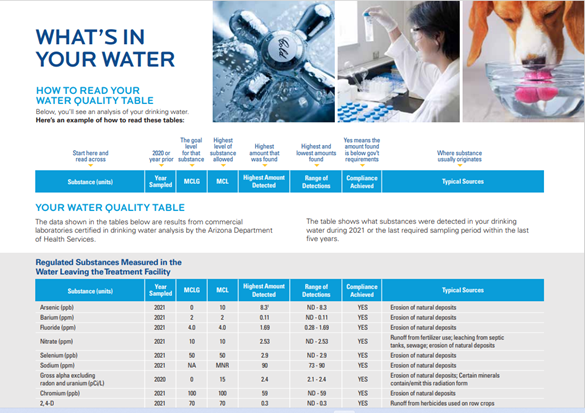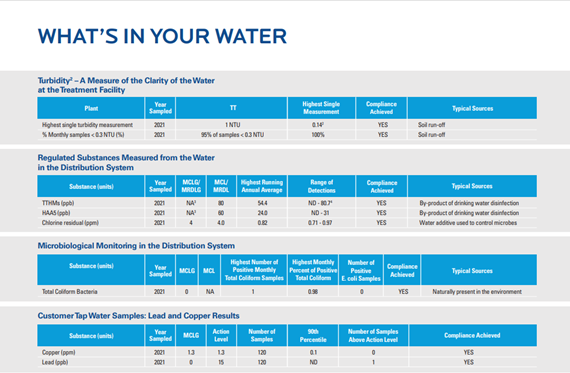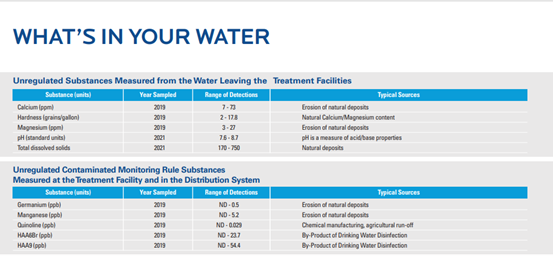Your Water Quality Report is prepared by your water source company, typically a municipality or a private water company. It should be readily available for you to review. The Environmental Protection Agency (EPA) developed standards for drinking water to ensure your water is safe to drink. There are two classifications of water standards established by the EPA, Primary and Secondary. Those substances in the primary category are EPA regulated and are associated with human health concerns when the levels are at or above the maximum contaminant levels (MCL’s). The Secondary Standard’s are not regulated by the EPA and are not necessarily for health concerns but for taste, appearance and smell.
The EPA regulates a list of nearly 90 Primary drinking water contaminants. Within the list the contaminants are divided into six categories:
1. Micro Organisms – bacteria, parasites and viruses.
2. Disinfectants – chlorine, chloramine and chloride dioxide.
3. Disinfection Byproducts – chloroform, bromate and chlorate.
4. Inorganic Chemicals – fluoride, mercury, lead, arsenic, nitrates and nitrites and many metal periodic table elements.
5. Organic Chemicals – benzene, tetrachloride and most dichlorobenzene compounds.
6. Radionuclides – uranium.
There are three Secondary drinking water standards, not regulated by the EPA:
1. Aesthetic Effects – affect taste, color and/or smell.
2. Cosmetic Effects – side effects from drinking tap water such as fluoride that may cause tooth spotting.
3. Technical Effects – may damage water equipment from scale deposits or corrode water pipes.
 Here’s and example of a Water Quality Report. The substances listed on the left are Primary drinking water contaminants, regulated by the EPA. The main areas of concern are the Highest Amount Detected and the MCL. If the Highest Level Detected is greater than the MCL, that could be an issue, contact your water source utility or company. The Highest Amount Detected must be lower than the MCL.
Here’s and example of a Water Quality Report. The substances listed on the left are Primary drinking water contaminants, regulated by the EPA. The main areas of concern are the Highest Amount Detected and the MCL. If the Highest Level Detected is greater than the MCL, that could be an issue, contact your water source utility or company. The Highest Amount Detected must be lower than the MCL.
If there is a substance that was not listed in the left column, it was not detectable. Lead, for example, is not listed, therefore, it was not detected in the lab results. With that said, lead in particular can enter your tap water from to water pipes in your home. We highly recommend that you filter all of your drinking water. There are simple to complex ways to filter your water. CLICK HERE to review options.
 On the left is page 2 of the Water Quality Report. Take note on the very bottom. There are lead levels that are non-detectable. 120 water samples were taken from random homes to determine if any lead was found in the tap water. Lead can be very detrimental to children and pregnant women health; therefore, it was prudent to test the tap water to ensure the water was free of lead. You can do the same too, contact a local EPA Certified Laboratory and have your tap water tested. And/or, filter all of your drinking water as we previously recommended.
On the left is page 2 of the Water Quality Report. Take note on the very bottom. There are lead levels that are non-detectable. 120 water samples were taken from random homes to determine if any lead was found in the tap water. Lead can be very detrimental to children and pregnant women health; therefore, it was prudent to test the tap water to ensure the water was free of lead. You can do the same too, contact a local EPA Certified Laboratory and have your tap water tested. And/or, filter all of your drinking water as we previously recommended.
 On the left is the final page of the report. One of the important elements on this page is the Hardness of the water. The Hardness is merely the amount of grains in a gallon of water. The primary constituents are calcium and magnesium.
On the left is the final page of the report. One of the important elements on this page is the Hardness of the water. The Hardness is merely the amount of grains in a gallon of water. The primary constituents are calcium and magnesium.
This water municipality rated the Hardness as:
1. Soft – less than 1 grain per gallon of water.
2. Slightly Hard – 1.3 to 3.4 grains per gallon of water.
3. Moderately Hard – 3.5 to 6.9 grains per gallon of water.
4. Hard – 7 to 10.4 grains per gallon of water.
5. Very Hard – greater than 10.5 grains per gallon of water.
To get a better understanding about water hardness read the report Hard Water – What Is That?
Additionally, If you have a concern about the hardness of your water, a simple solution is to use a water filter, Click Here, to review the various options.

